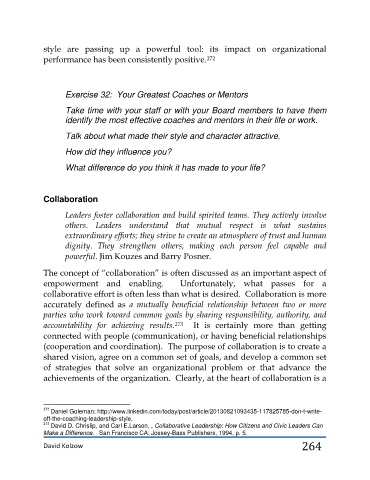Page 264 - 4- Leading_from_Within
P. 264
style are passing up a powerful tool: its impact on organizational
performance has been consistently positive. 272
Exercise 32: Your Greatest Coaches or Mentors
Take time with your staff or with your Board members to have them
identify the most effective coaches and mentors in their life or work.
Talk about what made their style and character attractive.
How did they influence you?
What difference do you think it has made to your life?
Collaboration
Leaders foster collaboration and build spirited teams. They actively involve
others. Leaders understand that mutual respect is what sustains
extraordinary efforts; they strive to create an atmosphere of trust and human
dignity. They strengthen others, making each person feel capable and
powerful. Jim Kouzes and Barry Posner.
The concept of “collaboration” is often discussed as an important aspect of
empowerment and enabling. Unfortunately, what passes for a
collaborative effort is often less than what is desired. Collaboration is more
accurately defined as a mutually beneficial relationship between two or more
parties who work toward common goals by sharing responsibility, authority, and
accountability for achieving results. 273 It is certainly more than getting
connected with people (communication), or having beneficial relationships
(cooperation and coordination). The purpose of collaboration is to create a
shared vision, agree on a common set of goals, and develop a common set
of strategies that solve an organizational problem or that advance the
achievements of the organization. Clearly, at the heart of collaboration is a
272 Daniel Goleman: http://www.linkedin.com/today/post/article/20130821093435-117825785-don-t-write-
off-the-coaching-leadership-style.
273 David D. Chrislip, and Carl E.Larson, , Collaborative Leadership: How Citizens and Civic Leaders Can
Make a Difference. San Francisco CA: Jossey-Bass Publishers, 1994, p. 5.
David Kolzow 264

